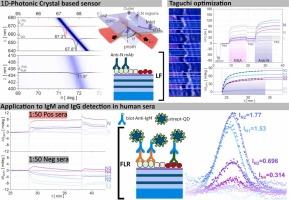光子晶体生物传感器CPTES化学的田口优化:检测人血清中抗sars - cov -2抗体
IF 3.7
1区 化学
Q1 CHEMISTRY, ANALYTICAL
引用次数: 0
摘要
表面功能化是生物传感器发展的关键一步,因为它直接影响生物识别元件的固定效率,从而影响生物传感平台的整体性能。在本研究中,我们采用Taguchi方法系统地优化了有机硅烷化合物氧化硅表面的功能化参数。该生物传感平台基于一维光子晶体结构,能够维持布洛赫表面波,从而实现高灵敏度的光学检测。使用田口正交阵列设计使我们能够有效地探索有限且具有代表性的参数组合集,显着降低了实验复杂性。一旦确定了最佳功能化条件,生物传感器将应用于分析从COVID-19患者和健康个体收集的人血清样本(稀释1:50)。该系统显示出特异性检测与SARS-CoV-2病毒相关的IgM抗体的能力,这些抗体通常以微量存在。这项工作提出了第一个基于田口的表面功能化策略的优化,通过无标记分子相互作用用于生物传感。该方法为优化和敏感检测临床相关生物标志物提供了一个平台,具有明确的诊断潜力。本文章由计算机程序翻译,如有差异,请以英文原文为准。

Taguchi optimization of CPTES chemistry for photonic crystal-based biosensors: Detection of anti-SARS-CoV-2 antibodies in human serum
Surface functionalization is a pivotal step in the development of biosensors, as it directly influences the immobilization efficiency of biological recognition elements and, consequently, the overall performance of the biosensing platforms. In this study, we employed the Taguchi method to systematically optimize the functionalization parameters of a silicon oxide surface using an organosilane compound. The biosensing platform is based on a one-dimensional photonic crystal structure capable of sustaining Bloch surface waves, which enable highly sensitive optical detection. The use of the Taguchi orthogonal array design allowed us to efficiently explore a limited and representative set of parameter combinations, significantly reducing experimental complexity. Once the optimal functionalization conditions were identified, the biosensors were applied to the analysis of human serum samples (diluted 1:50) collected from both COVID-19 patients and healthy individuals. The system demonstrated the ability to specifically detect IgM antibodies related to SARS-CoV-2 virus, which are typically present in trace amounts. This work presents the first Taguchi-based optimization of a surface functionalization strategy via label-free molecular interactions for biosensing. The approach provides a platform for both optimization and sensitive detection of clinically relevant biomarkers, with clear diagnostic potential.
求助全文
通过发布文献求助,成功后即可免费获取论文全文。
去求助
来源期刊

Sensors and Actuators B: Chemical
工程技术-电化学
CiteScore
14.60
自引率
11.90%
发文量
1776
审稿时长
3.2 months
期刊介绍:
Sensors & Actuators, B: Chemical is an international journal focused on the research and development of chemical transducers. It covers chemical sensors and biosensors, chemical actuators, and analytical microsystems. The journal is interdisciplinary, aiming to publish original works showcasing substantial advancements beyond the current state of the art in these fields, with practical applicability to solving meaningful analytical problems. Review articles are accepted by invitation from an Editor of the journal.
 求助内容:
求助内容: 应助结果提醒方式:
应助结果提醒方式:


